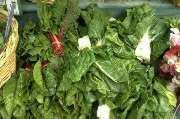Beta vulgaris
Swiss chard, Acelgas, Beets, Remolacha
Temperate
Introduction
Swiss chard is one of several important and closely related plants that evolved from the wild sea beet (Beta vulgaris ssp. Maritima). In addition to Swiss chard and sea beets, the species includes the common beetroot, the sugar beet, and spinach beets. These plants originated in the salty lands surrounding the Mediterranean Sea, and they are all tolerant of saline soil conditions. In its original form the plant was mainly useful as a source of greens. The familiar swollen beet root was gradually developed over hundreds of years of selective breeding. Large beet root varieties were developed as animal fodder and the sugar beet was a further development of the large fodder beets around the year 1800. Sugar beets, which have become the leading source of sugar in the temperate zones, are usually between 18-20% sugar while the common beetroot is only about 6% sugar.
Swiss chard is a nutritious green whose wide leaf stalks or petioles are often eaten like asparagus. It has some tolerance to both heat and light frost. Swiss chard is productive in a wide range of soil and climate conditions and is generally bothered less by pests and bolting (premature setting of seeds) than many other leaf crops.
Pros
- Beets have more soluble fibers than even oat bran. This helps normalize systolic blood pressure, reduce blood triglyceride levels, and improve the ratio of good (HDL) to bad (LDL) cholesterol.
- Tolerates saline soil
- Swiss chard has a strong taproot that can penetrate a meter or more in 60 days. This brings up nutrients hidden in the subsoil and improves soil structure for crops that follow.
- Swiss chard is a great cut-and-come-again vegetable. The outer leaves can be harvested after about 50 days and then once a week, leaving the innermost leaves to continue growing.
- Tolerates light frost, heat and some drought
Cons
- High levels of nitrates, especially when grown with high levels of soluble nitrogen fertilizer or at low temperatures or low light intensity
- High levels of oxalates, especially when grown at low temperatures
Notes
- Red color is largely from betacyanin, a compound closely related to anthocyanin which accounts for most of the red colors in plants.
- Though a temperate plant, it does well at high altitudes in the tropics, and is a standard commercial green in highland Mexican markets.
- Sensitive to soil pH below 6.0
- Lack of water will cause the leaf stalks to become very tough.
Seeds
- Swiss chard and beet seeds are generally available through garden and farm supply stores, hardware and even grocery stores and discount centers. A wider range of varieties is available through mail order seed houses.
Related Plants with Edible Leaves
Beta vulgaris ssp maritima (sea beet); B. vulgaris crassa group (table beet, sugar beet); B. vulgaris var. orientalis (spinach beet, palak); Chenopodium album (lambsquarters); C. quinoa (quinoa); C. murale (Australian spinach); C. bonus-henricus (good King Henry); Spinacia oleracea (spinach); Atriplex hortensis (orach); A. halimus (sea orach); A. canescens (fourwing saltbush)
